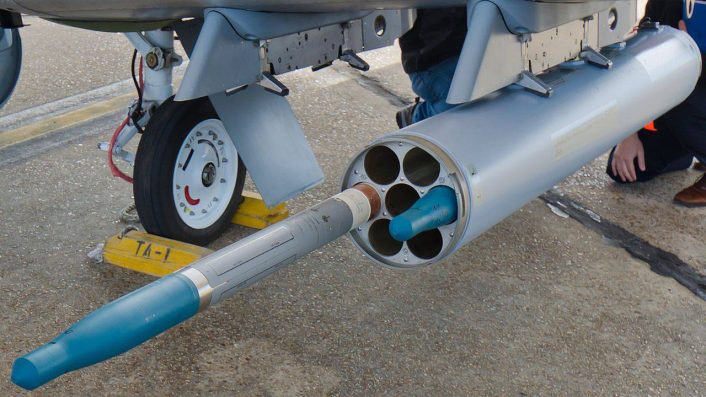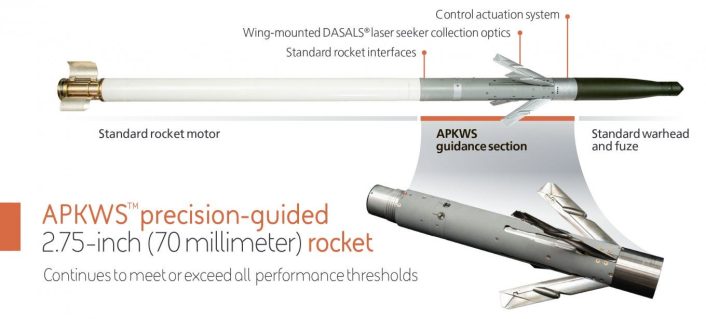The dual mode APKWS II rocket with both IR and laser guidance adds an improved Counter-UAS capability to fighter aircraft tasked to efficiently and affordably stop drone attacks.
BAE Systems has unveiled a new APK (Advanced Precision Kit) for the 70 mm Hydra rockets as a part of the APKWS II (Advanced Kill Precision Weapon System II) at the Sea Air Space 2025 conference in Maryland. The new kit consists of an IR (InfraRed) seeker in addition to the existing laser guidance, making this a dual-mode weapon.
The addition of an IR seeker would spare the pilots the need for continuous lasing of the aerial targets like the cheap kamikaze drones used by the Houthis, allowing them to swiftly move to other threats. Until now, the laser-guided variant has been used in this role thanks to specific upgrades.
As reported here at The Aviationist in Feb. 2025, U.S. Air Force F-16s deployed to the CENTCOM (Central Command) AOR (Area of Responsibility) have been employing the APKWS II in the air-to-air role against Houthi projectiles over the Red Sea since 2024. The laser-guided APKWS II was a solution to the cost disadvantage entailed by using the larger AIM-9 Sidewinder and AIM-120 AMRAAM, costing millions of dollars, against simple one-way attack drones, worth not more than $15,000.
Our partnerships run deep. ⚓
We deliver. We innovate. We show up strong. As a trusted anchor of the maritime industrial base, we’re committed to being a responsive and adaptive partner to the U.S. Navy and our allies. #SAS2025 pic.twitter.com/YNduQznZFA
— BAE Systems, Inc. (@BAESystemsInc) April 10, 2025
The APKWS II, designated as AGR-20 by the U.S. DoD, consists of a Hydra 70 mm unguided rocket with the addition of a laser guidance section between the 10-pound high-explosive warhead at the front and the Mk66 Mod 4 rocket motor at the rear. The U.S. Air Force’s 85th Test and Evaluation Squadron (TES) first tested the APKWS II in the air-to-air role on Dec. 19, 2019, shooting down a subscale drone in a proof of concept demonstration which saw an F-16 firing the rocket and guiding it on target with the targeting pod.
The weapon system underwent the Fixed Wing, Air Launched, Counter-Unmanned Aircraft Systems Ordnance (FALCO) upgrade program meant to improve the counter-UAS capabilities. BAE Systems says that the APK seeker is now the next stage in the rocket system’s evolution.
The next generation APK guidance kit adds an IR seeker to the nose of the rocket for dual mode seeker capability.
BAE Systems delivered the FALCO software upgrade as part of operational requirements needed to increase lethality in air-to-air engagements.https://t.co/HHjcdRdzhF pic.twitter.com/h9sfSPQQoM
— 𝔗𝔥𝔢 𝕯𝔢𝔞𝔡 𝕯𝔦𝔰𝔱𝔯𝔦𝔠𝔱△ 🇬🇪🇺🇦🇺🇲🇬🇷 (@TheDeadDistrict) April 9, 2025
The first modification to the APKWS
The laser guidance system introduced by BAE with the APKWS consists of a mid-body guidance unit which includes the Distributed Aperture Semi-Active Laser Seeker (DASALS) optics located on all four foldable guidance wings. These have a wide field of view to engage both moving and stationary targets in open areas.
BAE Systems explains that the system requires no modifications to the rocket, firing platform or fire control system. In fact, APKWS only needs a longer variant of the LAU-131/A seven-round rocket pod, called the LAU-131 A/A (the Navy uses the AGR-20 with the similar LAU-68 F/A).

The AGR-20 FALCO is an upgrade over the APKWS II, which includes software upgrades to increase the lethality of the weapon in air-to-air engagements against UAS. This variant is currently fielded in the CENTCOM AOR and, according to Naval News, is being used with a high probability of kill.
FALCO was a response to an emerging operational need and, after being seamlessly rolled out, enabled a significant improvement in the U.S. Air Force’s counter-UAS capabilities. The new APK’s IR seeker builds on these new capabilities, improving even more the C-UAS capabilities of the service.
The APKWS II is also being used in a unique ground-based C-UAS role against low-flying, slow and cheap drones. Among the platforms in this role are the EAGLS (Electronic Advanced Ground Launcher System), deployed by the U.S. military in the Middle East, and the VAMPIRE (Vehicle-Agnostic Modular Palletized ISR Rocket Equipment), supplied by the U.S. to Ukraine to counter Russian drones. It is unclear if these systems will employ the new seeker.

How does the new seeker help?
The APKWS II’s short range and small warhead are not a drawback if the targets are going to be attritable, slow-moving drones, as the targets’ dimensions mean they need to be engaged at shorter ranges and require smaller warheads to be destroyed. The seven-round pod on a single hardpoint also allows a deeper magazine depth when engaging swarms or continues waves of such attacks.
The F-16s in the CENTCOM AOR have been flying with even two seven-round LAU-131 A/A pods with the AGR-20 FALCO rockets, beside two AIM-120s and two AIM-9s. The jet uses its onboard Litening or Sniper targeting pod to lase the target, however requiring the pilot to hold on to the target until the guided rocket strikes it.
U.S. Fighter aircraft shoot down Iran-backed Houthi one-way-attack drones with AGR-20 FALCO Advanced Precision Kill Weapon System (APKWS) Laser Guided 2.75″ Rockets.#HouthisAreTerrorists pic.twitter.com/bDoVnKwotc
— U.S. Central Command (@CENTCOM) March 19, 2025
The time consuming and tedious process risks allowing other targets to get through, instead of engaging several targets quickly. The new IR seeker eliminates the need for the constant lasing on the target. Naval News quoted the director of business development in precision guidance and sensing solutions at BAE Systems Dave Smialek, who said a pilot can now laser designate a target, fire the rocket, and move to the next target without holding the lase on that single threat. The rocket switches to the IR seeker that guides it to the target after being released, dropping the second leg of the laser designation from the loop.
“The next generation APKWS is dual mode. An infrared seeker and laser guidance kit with a mid-body warhead. The dual mode gives the ability to increase the rate of fire without holding the designation on the target. Lase, APWKS heads towards the target, and you can go to pseudo-fire and forget [with IR]. Lase, fire, next target, lase fire,” Smialek explained.
The USAF has since confirmed the deployment of the APKWS – under the designation AGR-20 FALCO – to intercept strike drones and similar – fairly slow, non-responsive, poorly/non-maneuvering aerial targets – in the Red Sea. pic.twitter.com/w8tH4IhLJs
— Shahryar Pasandideh (@shahpas) April 9, 2025
Conclusion
The Houthis’ unrelenting salvos of drones and anti-ship cruise and ballistic missiles set an unprecedented trend in modern warfare. It is the largest naval battle since World War II, where U.S. warships and aircraft carriers were fired at for the first time, and the unpredictable timings and intensity also led to reports of crew fatigue and stress.
While the APKWS does address the asymmetry in the cost and complexity involved in the attacks and defense, the launching platforms are still larger capital weapons like F-16s costing tens of millions of dollars apiece. This is sustainable only to a certain extent, but it is already an improvement.
A large manufacturing power like China could undertake a combined asymmetric and conventional projectile attack from both land, air and sea, with an intensity even higher than the one of the Houthis’ attacks. This shows how the U.S. military still has a long way to go in preparing for a conventional war with a peer adversary, although work is moving in the right direction to fill the gaps.









